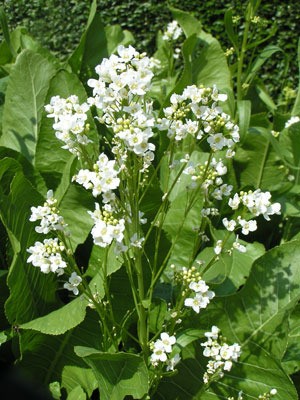
Botanical Name:
Cochlearia armoracia/Armoracia rusticana
Common names:
Horseradish, Mountain Radish
Description:
Horseradishes are perennial herbs with large, fleshy roots and course, rough-textured leaves. They are cultivated for their pungent, aromatic roots, which are used primarily as a food condiment.
Life Cycle:
hardy perennial
Exposure:
full sun or partial shade
Cultivation:
Horseradish is considered invasive. It will spread quickly throughout the garden if not carefully controlled. Plant 1 or 2 plants as soon as the soil is workable in the spring. To start horseradish, plant a 6 to 8 inch piece of root that has been severed from a mature plants. If you purchase the piece, the "root" end of the piece (the end you'll plant) will be the tapered end. Work the soil to a depth of at least 8 inches and prepare a hole for the root that is 4 to 6 inches deep. Cover the bottom two inches of the hole with compost and place the root in the hole at an angle so the new roots will grow out from the sides of the piece and not straight down the hole and end up tangled. The top of the root should be 2 inches below the soil.
Propagation:
roots cuttings, seed
Parts Used:
root
Harvesting and Storage:
Harvest roots when they reach the desired size. Clean roots under running water to prevent your eyes from watering, and store roots in tightly sealed jars filled with vinegar or oil until use.
Medicinal Uses:
used in the treatment of respiratory problems
Culinary Uses
Mix small amounts of Horseradish with creams, yogurt, mayonnaise, soft cheeses or salad dressings to make sauces to accompany meat, fish, and potatoes.
Other Uses:
skin care
